Melbourne University Football Club
| University | |
|---|---|
| Names | |
| Full name | Melbourne University Football Club |
| Nickname(s) | Students, Blacks, Blues, MUGARS |
| Club details | |
| Founded | 1859 |
| Colours | Black Blue |
| Competition | Victorian Amateur Football Association, Victorian Football League, Victorian Women's Football League |
| Chairman | Andrew Donald (MUFC); Nick Carah (University Blacks); Joseph Sturrock (University Blues); Laura Kane (Women's) |
| Coach | Cameron Roberts(University Blacks); Quinton Gleeson(University Blues); Andrew Jago (Women's) |
| Captain(s) | Bede Mahon(University Blacks); Matthew Torney (University Blues); Madeline Keryk, Alicia Eva, Kaitlyn Ashmore, Emma Kearney, Elyce Hay, Ellie Blackburn & Cat O'Bryan (Co-Captains, Women's) |
| Ground(s) | East Melbourne Cricket Ground (past) |
| University of Melbourne (present), Princes Park (present) | |
| Other information | |
| Official website | http://www.melbunifootball.com/ |
Melbourne University Football Club, often known simply as University, is an Australian rules football club, representing the "Blacks", "Blues" and "MUGARS". The Blacks and the Blues both compete in the Victorian Amateur Football Association in the William Buck Premier Division, and the MUGARS compete in both the Victorian Football League and Victorian Women's Football League.
The club achieved prominence by being a member of Victoria's elite competition in the early 20th century, the Victorian Football League (the forerunner of the Australian Football League) between 1908 and 1914.
Although there are no records of its exact formation, University's first recorded match took place in the same month that the Castlemaine Football Club was formed making it likely that University is the second oldest club in Australia after Melbourne.
History
Early history
University was founded in 1859 by students and graduates of the University of Melbourne. The first report of the university participating in a match was against St Kilda in June 1859. According to ‘Gymnastic’, writing in the sporting newspaper Bell's Life in Victoria, the ‘long pending match’ finally came off between two teams of 15. University was captained by a player called Phillips and St Kilda emerged the winners, under the method where the first team to score two out of three goals was victorious.
That same year it played against teams from Albert-park, Carlton, Melbourne, Royal Park and South Yarra. In 1861, University defeated Melbourne to win the first ever trophy for Australian football, instituted as part of the Calendonian Society's Games.
During the 1870s, the club played in the Second Twenties competition, one level lower than the main competition, the South Yarra Challenge Cup. From 1885 to 1888, University played in the VFA which at the time was the sport's major governing body. Following these years, the club was variously dormant or played in other competitions including the Metropolitan Junior Football Association, the Colleges Football Association and from 1905 to 1907 was a dominant member of the Metropolitan Football Association.
VFL history
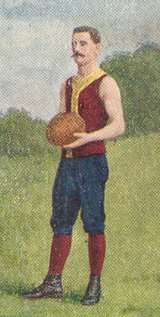
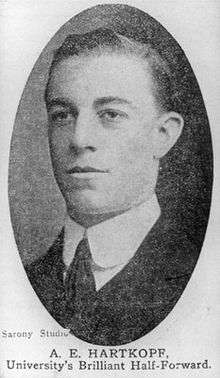
On 4 October 1907 the eight founding clubs of the VFL voted unanimously to include University in the league as its ninth team.[1] Richmond Football Club became the 10th team two weeks later. The club's home ground was originally the East Melbourne Cricket Ground, where it was a tenant of the Essendon Football Club; after a lengthy dispute with Essendon over rent, the club relocated to the Melbourne Cricket Ground which it also shared, this time with the Melbourne Football Club.
The club was nicknamed The Students, The Professors and The Shop. The players wore a black guernsey with a blue chevron and blue collars and cuffs (the same design is still used to this day), black and blue socks and an optional black and blue cap. Players had to have matriculated or hold a higher degree to be eligible to play in the team.
The club was not particularly successful: it never finished higher than sixth in the ten-team competition, and never played in the finals. It finished last in the competition from 1911 to 1914, and lost its last 51 games in a row. In total, it played 126 games for 27 wins, 2 draws and 97 losses between 1908 and 1914.
The club is unique among VFL/AFL clubs in never having any professional players, and this was a major factor in its decline in competitiveness after 1911, when player payments were becoming common amongst the other clubs. It became clear that the club could not remain competitive or viable in the VFL if it wished to remain amateur; and the fact that its players were focussed primarily on their studies, particularly during mid-year examinations, was another logistical issue for the club. As a consequence, the club withdrew from the VFL at the end of 1914. Many of its players transferred to the Melbourne Football Club, under an informal agreement between the clubs aimed at keeping the best University players together in the same club to keep the University intervarsity team strong.[2][3]
VFL Honour roll
| Year | Position | Coach | Captain | Leading goalkicker (goals) |
|---|---|---|---|---|
| 1908 | 6 | Tom Fogarty | Martin Ratz (25) | |
| 1909 | 7 | Harry Cordner | Albert Hartkopf (19) | |
| 1910 | 6 | Gerald Brosnan | Edgar Kneen | Albert Hartkopf (30) |
| 1911 | 10 | Gerald Brosnan | George Elliot | Albert Hartkopf (19) |
| 1912 | 10 | Gerald Brosnan | George Elliot | Roy Park (22) |
| 1913 | 10 | Victor Upton-Brown | Bert Hurrey | Roy Park (53) |
| 1914 | 10 | Gerald Brosnan | Jack West | Roy Park (36) |
University VFL Players
Overall, 112 players played at least one game for University in the Victorian Football League between 1908 and 1914; and, of that 112, at least 20 died in active service in either World War I or World War II (see List of Victorian Football League players who died in active service).
Bert Hurrey played the most amount of games for the club (101), and was the only University player to play at least 100 games in the VFL. Roy Park was the club's leading goalscorer, kicking 111 goals between 1912 and 1914, including winning the VFL's Leading Goalkicker Award in 1913 with 53 goals for the home-and-away season, a remarkable effort considering the team itself managed only 115 [4] and finished last on the ladder without a win.
VFL Coaches
The following is a list of coaches to have coached the club in the VFL.
- P = Played
- W = Won
- L = Lost
- D = Drew
- W% = Win percentage
| No. | Coach | P | W | L | D | W% | Years |
| 1 | Gerald Brosnan | 72 | 12 | 60 | 0 | 16.67 | 1910-14 |
| 2 | Victor Upton-Brown | 18 | 0 | 18 | 0 | 0.00 | 1913 |
Return to football
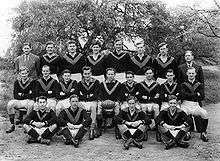
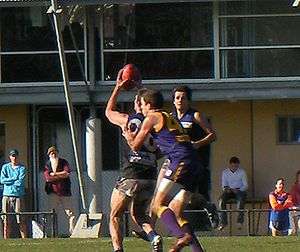
In the summer of 1919, after the War, Melbourne University began to rebuild its football involvement. Deciding not to reapply for a position in the VFL, they were instead requested by the VFL to supply two teams to the newly formed VFL Reserves competition, or the Victorian Junior Football League. These two teams were initially called University A and B, but soon became known as "University Blues" and "University Blacks", respectively (the teams were only officially called the Blues and Blacks in 1930). The Blues contested the 1919 and 1920 VJFL Grand Finals, losing to Collingwood on both occasions; the Blacks, who joined the 1919 VJFL season only at short notice when Melbourne was unable to organise its own junior team,[5] moved to the Metropolitan Amateur Football Association in 1920, and the following season, were joined by the Blues. Both contested the 1921 MAFA Grand Final, with the Blacks winning what to date is the only grand final the two teams have contested in the MAFA or VAFA.
Melbourne University students and alumni continue to maintain their involvement in football through the Blues and Blacks. The Melbourne University Football Club is unique in that it only plays as "Melbourne University" in inter-university matches, and its regular weekly competition is provided through its component teams, University Blues and University Blacks. The Blues and Blacks play in the Victorian Amateur Football Association, and have been a perennial power in the highest division of a high-standard amateur competition.
Up until the 1950s, the Blacks were the leading University side as well as one of the dominant sides in the Amateur competition, winning 11 A Section premierships by 1949. However, in the later part of the century the Blues established themselves as the premier University side, and are currently the longest serving club to play in the top division of the VAFA.
The Blacks have won a total of 14 A section flags (their most recent in 2014 & the most in the VAFA).The Blues have won a total of 3 A section flags (with their most recent being in 2004).
Throughout their history, the Blues and Blacks have often played together in A section of the MAFA/VAFA, and with the Blacks return to A section in 2008 after a prolonged absence, the teams met again for the first time in 25 years. In head to head matches, the Blues lead the win tally with 43 wins to the Black's 36 and one draw. The Blacks and the Blues are set to add to their head to head history in 2015 after the Blues won promotion after only one year in B section in 2014.
Both teams have consistently been a spawning ground for young players who go on to the AFL. To date 240 MUFC players have played in the VFL/AFL competition. Latest is Daniel Nicholson (Melbourne 2011)
From 1955 until 1996, an additional team was fielded by the club called "University Reds" which competed in the lower sections of the VAFA with a firsts and reserves team. When the team was discontinued by the club, players and supporters of the team decided to keep the team operating and it continues to this day as Fitzroy Reds. The Fitzroy Reds merged with the Fitzroy Football Club in 2008.
Formation of Women's Football Side
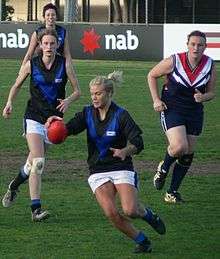
A women's side was formed In 1996 as a stand-alone side that did not fall under the Melbourne University Football Club. The club was named Melbourne University Women's Football Club and was nicknamed the MUGARS, an acronym for Melbourne University Girls Australian Rules Squad. In 2016, the MUWFC became apart of the MUFC and is equally represented alongside the Blacks and Blues sides on the MUFC board.
The MUWFC field three senior sides and three junior sides across three different leagues. Historically having senior teams in both the Victorian Women's Football League and WRFL/EDFL Youth Girls Competition, in 2016, upon formation of the inaugural statewide competition aligned with the Victorian Football League, MUWFC entered a senior side, with a second and third team competing in the Premier Division and Division 3 of the Victorian Women's Football League respectively. The WRFL/EDFL Youth Girls Competition also expanded from under 13s side and under 18s side to also include and under 15s side.
In 2002, MUWFC won their first premiership against St Albans in Division 1. This was followed by double premierships in 2003 and 2005, to make up the club's five premierships.
The MUWFC is Australia's largest women's football club, with over 150 registered players and officials registered in the 2016 season, over six teams.
See also
- Category:University Football Club players
- Adelaide University Football Club
- Sydney University Students AFC
- University of Queensland Australian Football Club
External links
- Melbourne University Football Club Home Page
- Complete University Player Records
- Victorian Amateur Football Association
- University Blues Home Page
- University Blacks Home Page
- Full Points Footy History of the University Football Club
- University Jumpers on Footyjumpers.com
- Melbourne University Women's Football Club
References
- ↑ There was a proposal at least as early as 1898: A University Team, The Argus, (Monday, 18 July 1898), p.7.col.H.
- ↑ "The University Team". The Argus. Melbourne, VIC. 18 September 1914. p. 4.
- ↑ "Exit University – Football League Retirement". The Argus. Melbourne, VIC. 17 October 1914. p. 20.
- ↑ http://afltables.com/afl/seas/1913.html
- ↑ "Football". The Age. Melbourne, VIC. 15 May 1919. p. 10.
- Black & Blue: The Story of Football at the University of Melbourne. J Cordner et al., 2007.
- Kevin Taylor, The Sydney Swans. Allen & Unwin, 1987.
- Rodgers, S and A Browne, Every Game Ever Played : VFL/AFL Results 1897-1997, (Ringwood, Vic. : Viking, 1998)